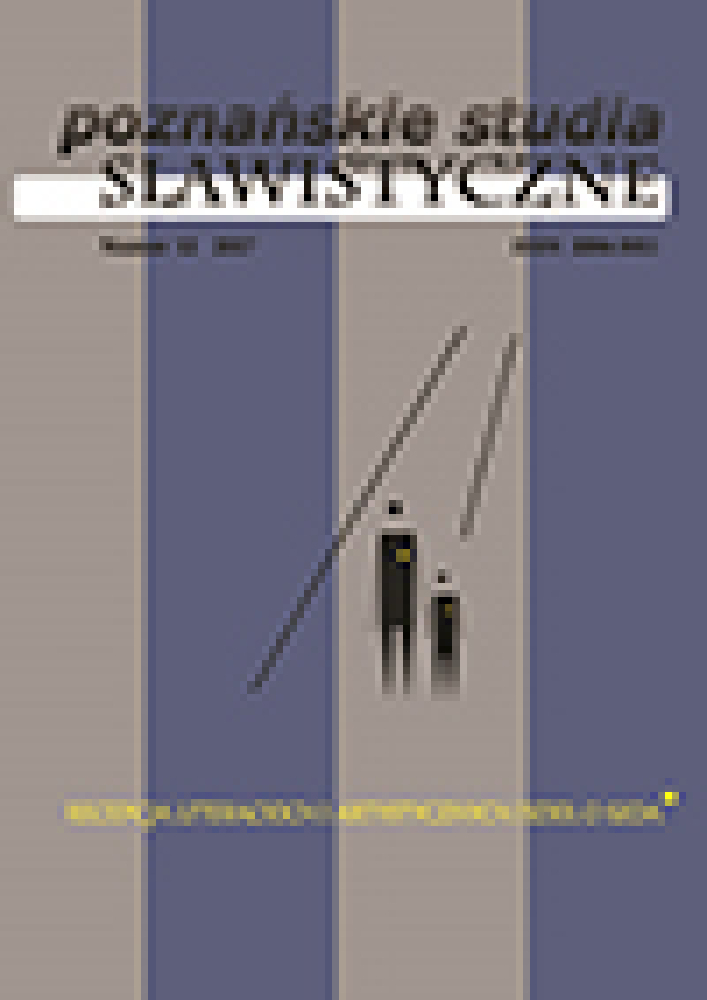Abstrakt
This article implies that the impact of cinematic fiction on the capability to imagine and comprehend the trauma of the Holocaust is formed at the intersection of aesthetic, moral, social and ideological frames in particular society. Cinema had a special role for the unification of the Holocaust memory since 1990. In the post-Yugoslav cinema two feature films (Lea and Darija, 2011 and When Day Breaks, 2012) represent the cinematic paradigm shift in dealing with the difficult heritage of the Holocaust in Croatia and Serbia following the break of communism. Although they suffer from apolitical approach to historical issues and mitigate the consequences of local collaboration with the Nazis, as well as take the child as „the figure of infantilization” of the Holocaust (Hirsch 2012), their influence on the “postmemory generation” and the pedagogy of trauma in the region is significant and socially relevant.Bibliografia
Agamben G., 2010. Vrijeme što ostaje: komentar uz Poslanicu Rimljanima, prev. M. Kopić, Zagreb.
Asman A. [Assmann Aleida], 2011, Duga senka prošlosti, prev. D. Gojković, Beograd.
Badurina N., 2010, Vrijeme traume, vrijeme svjedočenja. Testimonijalna literatura i književni kanon tijekom dvadesetog stoljeća, u: Komparativna povijest hrvatske književnosti. Zbornik radova XII. Istodobnost raznodobnog. Tekst i povijesni ritmovi, ur. C. Pavlović, V. Glunčić-Bužančić, A. Meyer-Fraatz, Split–Zagreb, str. 189–201.
Banović S., 2012, Država i njezino kazalište. Hrvatsko državno kazalište u Zagrebu 1941.–1945, Zagreb.
Domaš J. (ur.), 2015, Glasovi, sjećanja, život: prilog istraživanju povijesti židovskih obitelji, Zagreb.
Ewen S., Dery M., 2004, Reklame za posljednju generaciju, prev. L. Furlan, „Libra libera” br. 14, str. 35–40.
Felman S., Laub D., 1992, Testimony. Crises of Witnessing in Literature, Psychoanalysis, and History, New York–London.
Friedlander S. (ur.), 1992, Probing the Limits of Representation, Cambridge–Mass– –London.
Goldstein I., Goldstein S., 2001, Holokaust u Zagrebu, Zagreb. Goldstein S., Goldstein I., 2011, Jasenovac i Bleiburg nisu isto, Zagreb.
Grlić E., 1997, Sjećanja, Zagreb.
Haltof M., 2012, Polish Film and the Holocaust: Politics and Memory, Oxford–New York.
Hicks J., 2012, Soviet Cinema and the Genocide of the Jews, 1938–1946, Pittsburgh.
Hirsch M., 2012, The Generation of Postmemory: Writing and Visual Culture After the Holocaust, New York.
Ivanji I., 2013, Naše smrti i vaš život, „Vreme”, 13.09., , 15.02.2016.
Jakovljević I., 1999, Konclogor na Savi, Zagreb.
Jambrešić Kirin R., 2007, Šalje Tito svoje na ljetovanje!: ženska trauma i arhipelag Goli, „Treća: časopis Centra za ženske studije” br. 9/1, str. 9–38.
Jergović M., 2012, Čestitije se u hrvatskoj kulturi o holokaustu nije govorilo, , 15.01.2016.
LaCapra D., 2001, Writing History, Writing Trauma, Baltimore. Levi P., 1993, Zar je to čovjek?, prev. T. Klarić, Zagreb.
Levi P., 2009, Raspad Jugoslavije na filmu: estetika i ideologija u jugoslavenskom i postjugoslavenskom filmu, prev. A. Grbić, S. Glišić, Beograd.
Ličanin A., 2015, Dvije ljubavi i jedan rat Eve Panić Nahir, Čakovec.
Logan W., Reeves K. (ur.), 2009, Places of Pain and Shame: Dealing with “Difficult Heritage”, London–New York.
Miller E., 2004, Izabran za umiranje, Zagreb.
Neufeld E., 2000, Svjedočanstvo preživjelog, „Novi Omanut”, str. 42–43.
Ožegović N., 2006, Priča o Lei Deutsch: Film o tragičnom usudu dječje zvijezde, „Nacional” br. 565, 11.09., 15.12.2015.
Pal A., 2011, Gorući grm: Alfred Pal – život i djelo, prir. B. Žižić, Zagreb.
Pavičić J., 2011, Postjugoslavenski film: stil i ideologija, Zagreb.
Poirier A., 2013, Claude Lanzmann returns to the Holocaust „The Guardian”, 14.05., , 17.02.2016.
Radić D., 2012, Život u NDH, „Novosti” br. 632, 11.02., , 25.02.2016.
Schreiner P., 2014, Spašeni iz Zagreba: sjećanja troje preživjelih srodnika na hrvatski Holokaust, prev. S. Glavaš, Zagreb.
Sontag S., 1975, Fascinating Fascism, „New York Review of Books” 6.02., 5.02.2016.
Sontag S., 2005, Prizori tuđeg stradanja, prev. B. Jakovlev, Zagreb.
Taczyńska K., 2014, Diskurs o logoru Goli otok – ženska perspektiva, „Knjiženstvo: časopis za studije književnosti, roda i kulture”, br. 4, , 23.09.2016.
Wlodarski A.L., 2015, Musical Witness and Holocaust Representation, Cambridge.
Licencja
Prawa autorskie (c) 2017 Renata Jambrešić Kirin

Utwór dostępny jest na licencji Creative Commons Uznanie autorstwa – Bez utworów zależnych 4.0 Międzynarodowe.
